Abstract
1 Strips of urethra taken from guinea-pigs contracted in response to acetylcholine, noradrenaline (via alpha-adrenoceptors) and 5-hydroxytryptamine, and were relaxed by adenosine triphosphate (ATP) if the tone was raised. Isoprenaline produced relaxation of bladder strips (via beta-adrenoceptors) whereas ATP caused contraction. 2 Atropine completely blocked all responses to acetylcholine; quinidine failed to block ATP responses selectively; methysergide blocked responses of the urethra but not the bladder to 5-hydroxytryptamine. 3 Spontaneous electrical activity was recorded with intracellular microelectrodes from all regions: in the urethra infrequent bursts of spikes occurred at 1-7 min intervals; regular spikes at 6-30/min were recorded from the detrusor muscle. In the bladder base, bursts of spikes were superimposed on the regular pattern. 4 Bursts of spikes in the urethra were initiated by noradrenaline, phenylephrine or acetylcholine and inhibited by ATP; regular spikes in the bladder were accelerated by acetylcholine or ATP and slowed by noradrenaline or isoprenaline. 5 The intrinsic electrical activity and pharmacological properties of the urethra therefore differ from those of the bladder. This may account for the different responses of the two regions in normal function.
Full text
PDF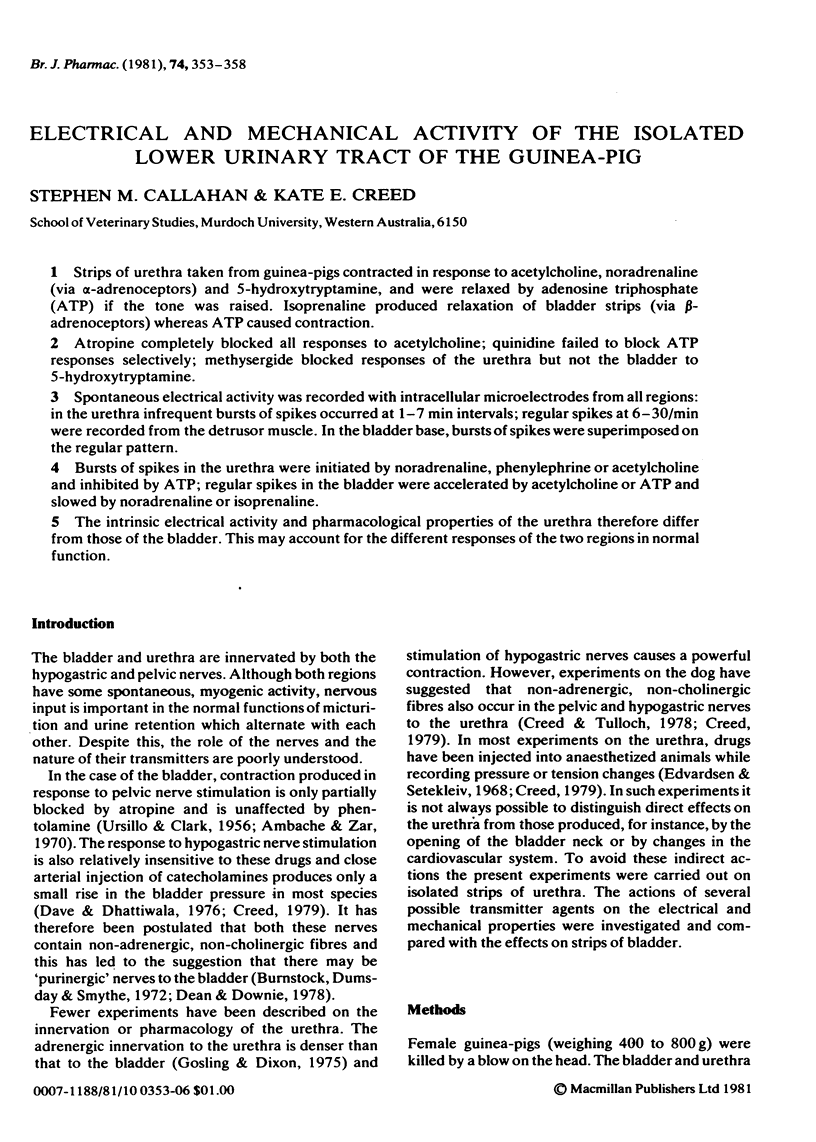
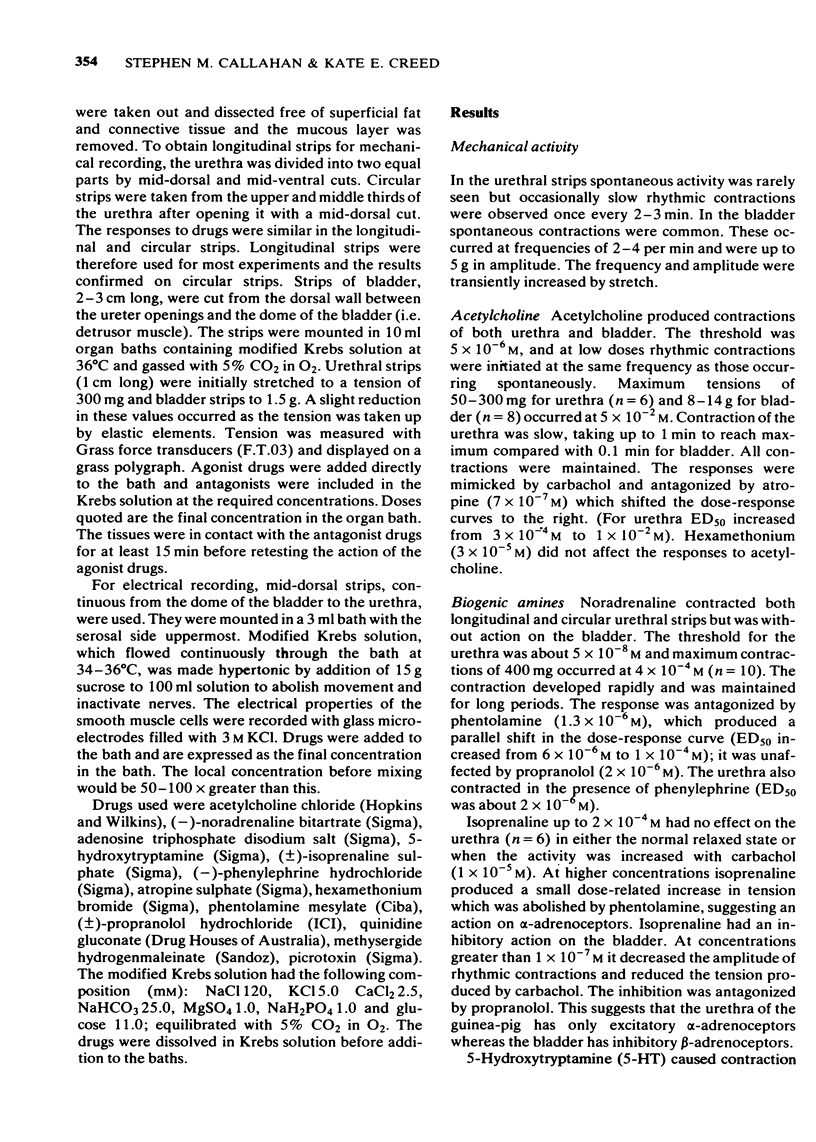
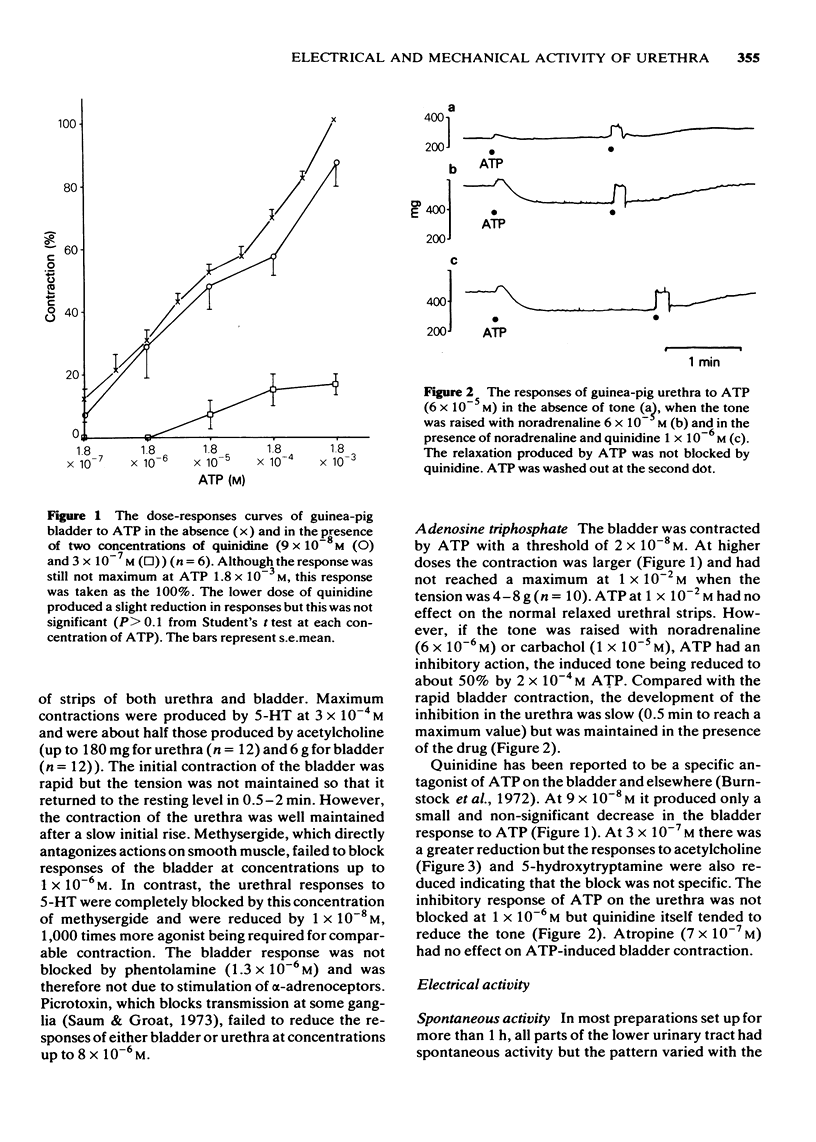
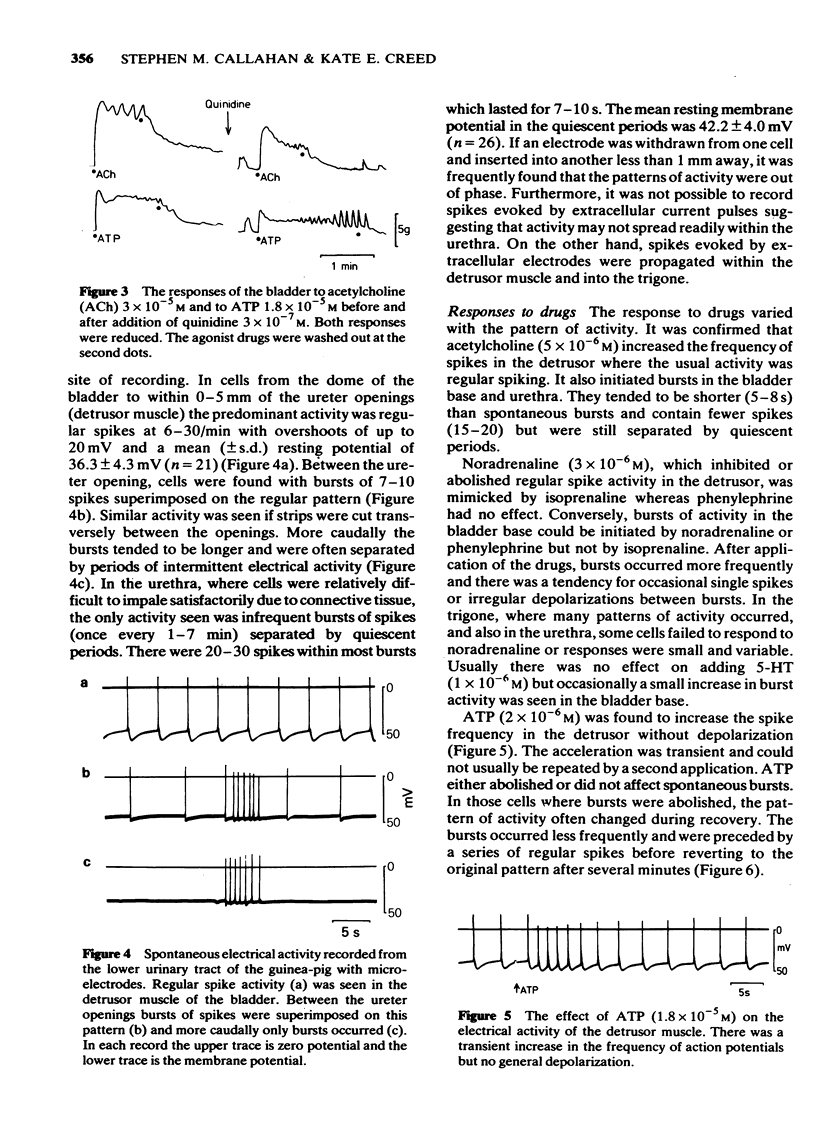
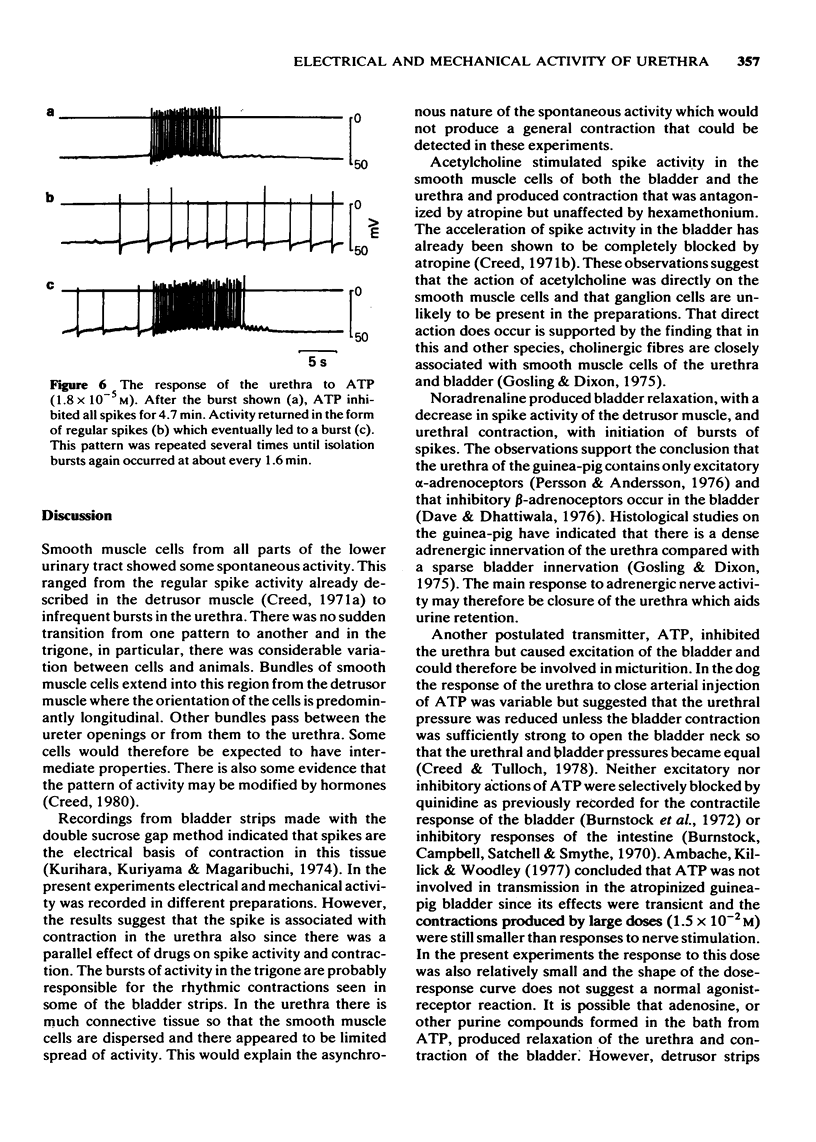

Selected References
These references are in PubMed. This may not be the complete list of references from this article.
- Ambache N., Killick S. W., Woodley J. P. Evidence against purinergic motor transmission in guinea-pig urinary bladder [proceedings]. Br J Pharmacol. 1977 Nov;61(3):464P–464P. [PMC free article] [PubMed] [Google Scholar]
- Ambache N., Zar M. A. Non-cholinergic transmission by post-ganglionic motor neurones in the mammalian bladder. J Physiol. 1970 Oct;210(3):761–783. doi: 10.1113/jphysiol.1970.sp009240. [DOI] [PMC free article] [PubMed] [Google Scholar]
- Burnstock G., Campbell G., Satchell D., Smythe A. Evidence that adenosine triphosphate or a related nucleotide is the transmitter substance released by non-adrenergic inhibitory nerves in the gut. Br J Pharmacol. 1970 Dec;40(4):668–688. doi: 10.1111/j.1476-5381.1970.tb10646.x. [DOI] [PMC free article] [PubMed] [Google Scholar]
- Burnstock G., Dumsday B., Smythe A. Atropine resistant excitation of the urinary bladder: the possibility of transmission via nerves releasing a purine nucleotide. Br J Pharmacol. 1972 Mar;44(3):451–461. doi: 10.1111/j.1476-5381.1972.tb07283.x. [DOI] [PMC free article] [PubMed] [Google Scholar]
- CLARK B. B., URSILLO R. C. The action of atropine on the urinary bladder of the dog and on the isolated nerve-bladder strip preparation of the rabbit. J Pharmacol Exp Ther. 1956 Nov;118(3):338–347. [PubMed] [Google Scholar]
- Creed K. E. Effects of ions and drugs on the smooth muscle cell membrane of the guinea-pig urinary bladder. Pflugers Arch. 1971;326(2):127–141. doi: 10.1007/BF00586905. [DOI] [PubMed] [Google Scholar]
- Creed K. E. The role of the hypogastric nerve in bladder and urethral activity of the dog. Br J Pharmacol. 1979 Mar;65(3):367–375. doi: 10.1111/j.1476-5381.1979.tb07840.x. [DOI] [PMC free article] [PubMed] [Google Scholar]
- Creed K. E., Tulloch A. G. The effect of pelvic nerve stimulation and some drugs on the urethra and bladder of the dog. Br J Urol. 1978 Oct;50(6):398–405. doi: 10.1111/j.1464-410x.1978.tb04218.x. [DOI] [PubMed] [Google Scholar]
- Dave K. C., Dhattiwala A. S. Adrenoreceptors of the guinea-pig urinary bladder. Br J Pharmacol. 1976 Sep;58(1):37–41. doi: 10.1111/j.1476-5381.1976.tb07690.x. [DOI] [PMC free article] [PubMed] [Google Scholar]
- Dean D. M., Downie J. W. Contribution of adrenergic and "purinergic" neurotransmission to contraction in rabbit detrusor. J Pharmacol Exp Ther. 1978 Nov;207(2):431–445. [PubMed] [Google Scholar]
- Edvardsen P., Setekleiv J. Distribution of adrenergic receptors in the urinary bladder of cats, rabbits, and guinea-pigs. Acta Pharmacol Toxicol (Copenh) 1968;26(5):437–445. doi: 10.1111/j.1600-0773.1968.tb00462.x. [DOI] [PubMed] [Google Scholar]
- Gosling J. A., Dixon J. S. The structure and innervation of smooth muscle in the wall of the bladder neck and proximal urethra. Br J Urol. 1975 Oct;47(5):549–558. doi: 10.1111/j.1464-410x.1975.tb06260.x. [DOI] [PubMed] [Google Scholar]
- Kurihara S., Kuriyama H., Magaribuchi T. Effects of rapid cooling on the electrical properties of the smooth muscle of the guinea-pig urinary bladder. J Physiol. 1974 Apr;238(2):413–426. doi: 10.1113/jphysiol.1974.sp010533. [DOI] [PMC free article] [PubMed] [Google Scholar]
- Persson C. G., Andersson K. E. Adrenoceptor and cholinoceptor mediated effects in the isolated urethra of cat and guinea-pig. Clin Exp Pharmacol Physiol. 1976 Sep-Oct;3(5):415–426. doi: 10.1111/j.1440-1681.1976.tb00619.x. [DOI] [PubMed] [Google Scholar]
- Saum W. R., De Groat W. C. The actions of 5-hydroxytryptamine on the urinary bladder and on vesical autonomic ganglia in the cat. J Pharmacol Exp Ther. 1973 Apr;185(1):70–83. [PubMed] [Google Scholar]


